Cicada killers are not aggressive and generally considered beneficial insects. But these large species of wasps remain safe for you in case you don’t irritate them and don’t disturb their nests.
When you have pets or children, cicada killers might be disturbed and become pretty aggressive, thus your family’s health might be at risk.
If you worry about the health of your family and the beauty of your lawn, keep reading this article. I will tell you everything about these species of wasps, how to identify them, and I will provide a step-by-step guide on how to get rid of them.
[wpsm_titlebox title=”How to Get Rid of Cicada Killer Wasps” style=”main”]
- Eliminate the food source.
- Fertilize the soil. Cicada killers do not nest in the hydric ground, they prefer light-textured soil.
- You can fill the burrows with water and wash away the piles of dirt surrounding them.
- Use wasp dust/liquid chemicals/aerosol against wasps.
- Keep your lawn in good condition.
[/wpsm_titlebox]
Buyer’s Guide
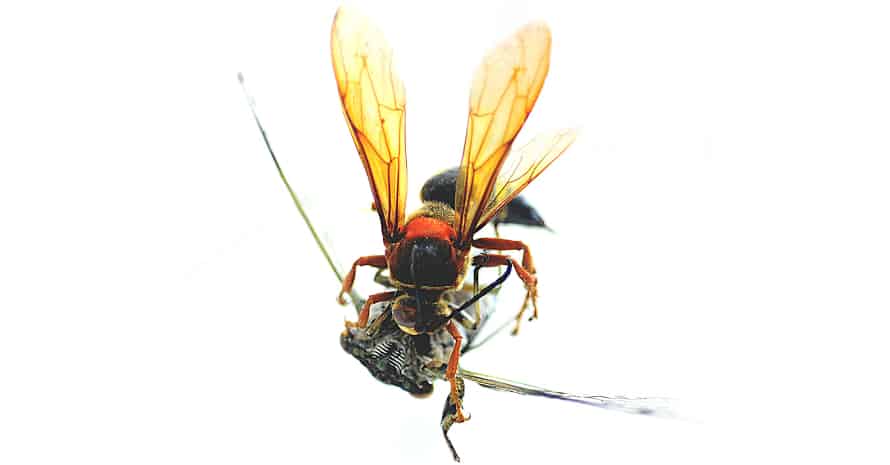
When you start a fight, you always need to know the characteristics of your enemy, his weaknesses and strengths. So here I’ll tell you everything you need to know about the cicada killer wasps and answer the most popular questions about them.
What Does a Cicada Killer Look Like?
Cicada killers are one of the largest species of wasps, adult female insects are up to 3 inches long.
They have segmented body in black and yellow stripes, the head and middle parts of the body are of a rust color. Their six legs’ color is from pale red to orange. Insects have yellow-brown tinted wings and antennae.
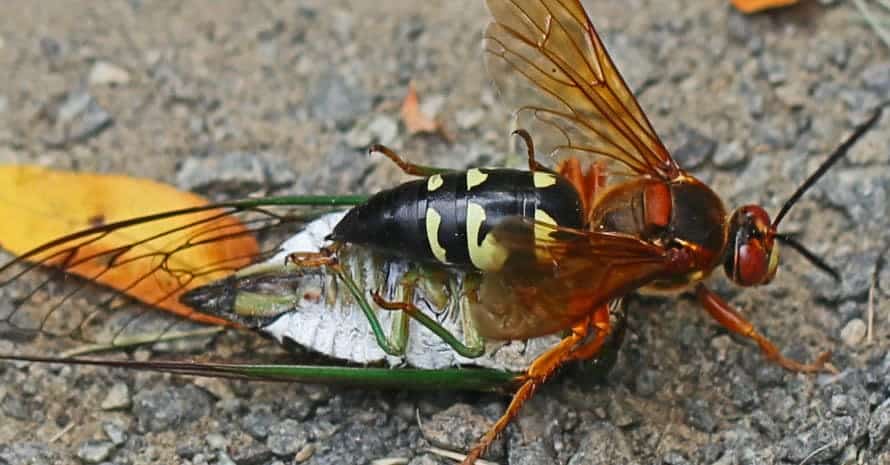
Where Do Cicada Killer Wasps Live?
These species create their nests in burrows in the ground. Their favorite places in populated areas are lawns and yards. They also like sidewalks, flowerbeds and sloped terrains. These wasps prefer to dig holes in sandy, soft and well-drained soil.
Cicada Killer Wasp Life Cycle
As in other insect species, males appear as adults first. They mate with females, emerging from the soil. After mating, females choose a place to create a burrow, which they supply with cicadas to feed the larvae. Cicadas stay alive but paralyzed by the venom of the wasp’s sting.
The female cicada killer makes a cell with one egg and two-three cicadas then seals the chamber. Pupation usually occurs in the spring and adult insects appear in June. Year by year, their number increases.

Cicada Killer Wasps Dangers
These insects destroy your lawn by burrowing nests in soil and creating tunnels, which can lead to serious results. Since cicada killers breed rapidly, they cause significant damage to lawns and bed flowers by their burrows.
These insects ruin your garden structure by digging and tunneling to lay the eggs and also destroy the roots system of your plants.
Although ground burrowing wasps are not aggressive, they sting when irritated, so your pets or kids playing in such a yard might be at risk too.
Related Post: How to Get Rid of Yellow Jackets
Signs of Cicada Killer Wasps Infestation
Here I’ll give you some tips on how to identify if you have cicada killer wasps on property:
- the ground feels mushy when you step on it;
- U-shaped tunnels in the ground with loose soil around the entrance;
- small granular dirt mounds (2 to 5 inches high);
- the hole of finger size at the foot of that mound.
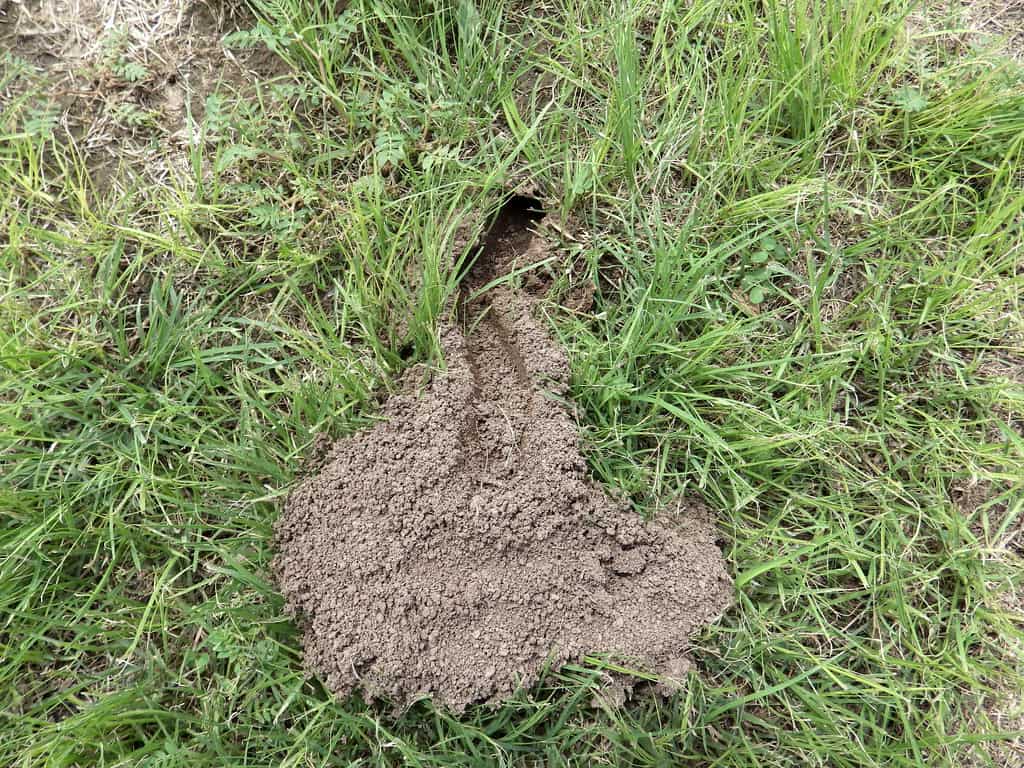
How to Get Rid of Cicada Killer Wasps?
You need to understand that even when you don’t hear buzzing and flying insects, it doesn’t mean your territory is free from dirt digger wasps. These insects leave their eggs in nests, which you can’t see, so getting rid of ground digger wasps requires an integrated approach and includes several steps. So here is a small guide for cicada killer wasp removal.
Step 1: Eliminate the food source
Сicadas is the main food source for cicada killers. When they don’t have enough food, they will start searching for other areas. Adult cicadas feed on flower nectar and fermented sap from large trees.
So when you eliminate large plants and flowers from your area, that will make your garden less attractive for cicada killer infestation.
Step 2: Fertilize the soil
Cicada killers do not nest in the hydric ground, they prefer light-textured soil. So for successful cicada killer wasp control, you need to check your soil for adequate lime and fertilizer level and promote thick turf growth. Also, make sure the infested area receives 1 inch of water per week.
Step 3: Get rid of cicada killer wasps
After you finish two first steps, you need to find a suitable way how to destroy cicada killer nests. You can fill the burrows with water and wash away the piles of dirt surrounding them. Some owners recommend using boric acid or vinegar for that goal.
Natural decisions are easy, but they will be less effective than professional remedies. There are different products which help you to exterminate cicada killers:
- wasp dust (it can be put onto each nest entrance);
- liquid chemicals (you can fill the nest with them);
- wasp aerosols (you can spray them at the nest entrances and directly onto the insects).
How to Prevent Cicada Killers in Future?

The best way to prevent cicada killer wasps in the future is to keep a well-maintained lawn, fertilized and wet enough, with no areas of bare soil. Thick turf and long grass in the middle of summer will also deter these burrowing insects from your area.
Best Cicada Killer Control Remedies
I already mentioned that despite the many natural ways for cicada killer wasp extermination, I prefer to trust checked and proven professional products. In this section, I will shortly review the top 3 of them.
1. Best Ground Digger Wasp Dust Killer – Delta Dust Insecticide by Bayer
[amazon box=”B005N4PQG6″ template=”vertical” button_text=”Check price on Amazon” button_detail=”https://shareasale.com/r.cfm?b=410159&u=2583381&m=43235&urllink=www%2Edomyown%2Ecom%2Fdelta%2Ddust%2Dinsecticide%2Dp%2D44%2Ehtml&afftrack=how%20to%20get%20rid%20of%20cicada%20killer%20wasps” button_detail_text=”Check price on DoMyOwn”]
Specifications:
- Active Ingredient: Deltamethrin 0.05%
- Coverage Area: 1 lb. Covers 1,000 sq. ft.
- Item Weight: 1.59 pounds
- Item Dimensions LxWxH: 10.47 x 9.21 x 2.8 inches
- Target Species: Ants, Bedbugs, Cockroaches, Fleas, Silverfish, Scorpions, Sowbugs, Millipedes, and numerous other pests
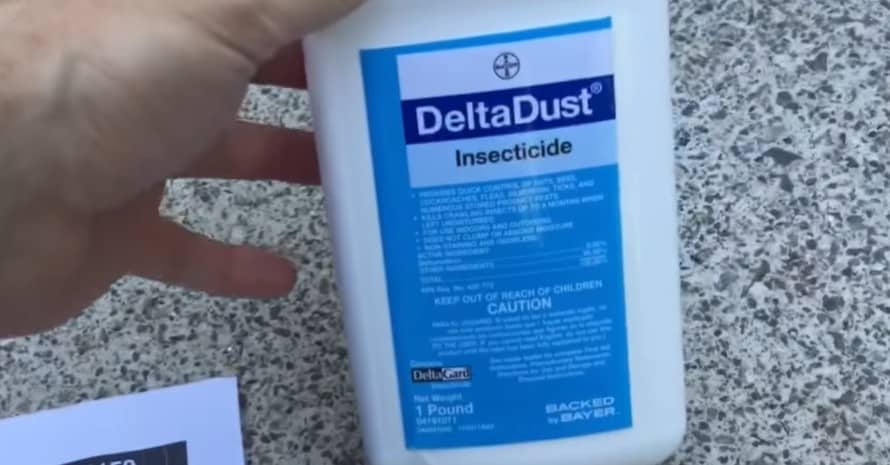
Delta Dust is a long-lasting insecticide for killing crawling animals. The active ingredient – Deltamethrin kills ants, fleas, scorpions, bedbugs, cockroaches, millipedes, sowbugs and other insects, including cicada killer wasps. When dust is left undisturbed, it works for 8 months after the application.
It doesn’t absorb moisture from the ground, which is especially important when used outdoors. The product is odorless, so can be applied indoors too. All you need to do is just to shake the duster and squeeze it, to provide the application of a thin layer. When used correctly, you will hardly see the dust lying on the surface.
| Pros: | Cons: |
|
|
2. Best Cicada Killer Wasp Insecticide Spray – Viper Insecticide
[amazon box=”B003FKTDXW” template=”vertical” button_text=”Check price on Amazon” button_detail=”https://shareasale.com/r.cfm?b=410159&u=2583381&m=43235&urllink=www%2Edomyown%2Ecom%2Fmartins%2Dviper%2Dinsecticide%2Dp%2D8908%2Ehtml%3Fsub%5Fid%3D2140&afftrack=how%20to%20get%20rid%20of%20cicada%20killer%20wasps” button_detail_text=”Check price on DoMyOwn”]
Specifications:
- Active Ingredient: Cypermethrin 25.4%
- Item Form: Spray
- Item Weight: 1.3 ounces
- Item Dimensions LxWxH: 3.9 x 1.8 x 7.9 inches
- Target Species: Ants, Firebrats, Boxelder Bugs, Fleas, Centipedes, Flies, Chiggers, Millipedes, Cockroaches, Mosquitoes, Pillbugs, Crickets, Silverfish, Earwigs, Sowbugs, Elm Leaf Beetle, Bees, Ticks, Wasps, Wood Infesting Beetles, Scorpions, Spiders, and others

Viper Insecticide is the answer to the question how to kill cicada killers quickly with residual control of insects for up to 3 months. Cypermethrin in the composition of this spray also helps to kill cockroaches, fleas, scorpions, ants, spiders, and many other pests.
This product is suggested as concentrated, so before application, you just need to mix it with water in proportion to 1,3 oz of concentrate to 1 gallon of water, shake the bottle, and spray it to infested areas. Perfectly fits for treating lawns and other outdoor areas, you can use it inside the house as well.
| Pros: | Cons: |
|
|
3. Best Solution for Direct Contact – Wasp Freeze
[amazon box=”B0001LE2D4″ template=”vertical” button_text=”Check price on Amazon” button_detail=”https://shareasale.com/r.cfm?b=410159&u=2583381&m=43235&urllink=www%2Edomyown%2Ecom%2Fpt%2Dwasp%2Dfreeze%2Dii%2Daerosol%2D175%2Doz%2Dp%2D60%2Ehtml&afftrack=how%20to%20get%20rid%20of%20cicada%20killer%20wasps” button_detail_text=”Check price on DoMyOwn”]
Specifications:
- Active Ingredient: Prallethrin 0.1%
- Item Form: Aerosol
- Item Weight: 1.09 Pounds
- Item Dimensions LxWxH: 2.63 x 2.63 x 11 inches
- Target Species: Wasps, Hornets, Yellow Jackets, Spiders
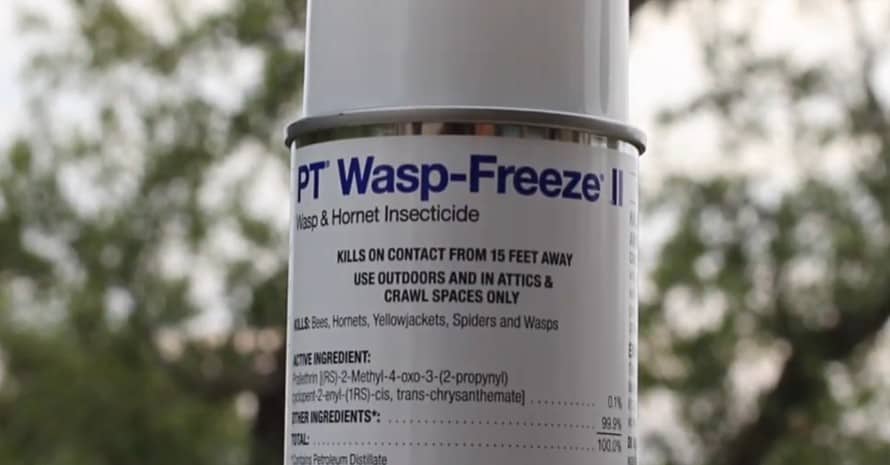
This spray was created specifically to knockdown bees, hornets, and all kinds of wasps. It’s fatal to insects even when to spray it on them at the distance of 15 feet away. Insecticide works so fast that stinging pheromone doesn’t release, and it reduces risks of being stung.
Wasp Freeze insecticide has residual activity, so it helps to eliminate not only wasps and hornets but also their nests.
| Pros: | Cons: |
|
|
FAQ
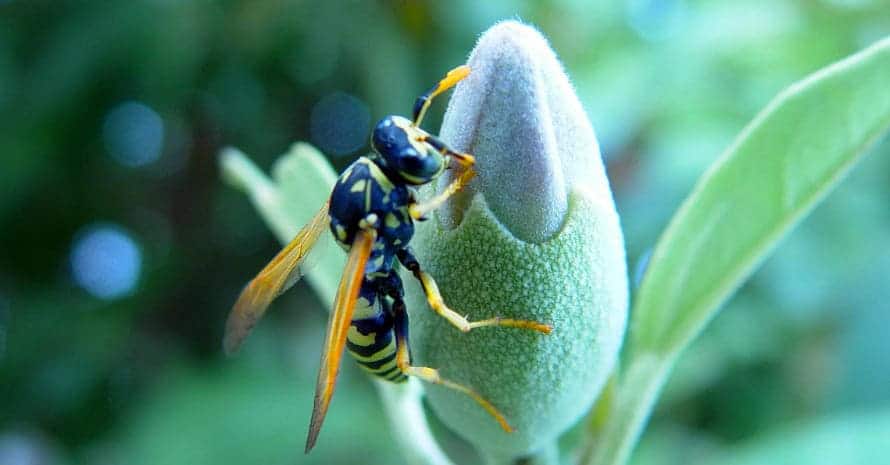
Do Cicada Killer Wasps Sting Humans?
Cicada killers use their large stinger for hunting for cicadas and they sting to paralyze their victim and feed to larvae. You need to work hard to provoke the female cicada killer wasp to sting you.
It will happen if you step on the insect with bare feet or try to catch it with bare hands. Male cicada killers may seem more aggressive defending their territory, although they can’t sting.
When Do Cicada Killer Wasps Return to Their Burrow?
A burrow of a cicada killer can contain up to 20 cells with 1 egg per cell. Egg hatches to larvae and feeds on cicadas. So the female cicada killer leaves the burrow to hunt for cicadas and bring them back to put into each cell with the egg.
What Attracts Cicada Killer Wasps?
Cicada killer wasps are attracted by well-drained, light texture sandy areas with sparse vegetation at the full sun. They also prefer areas with deciduous trees and flowers nearby, and of course with plenty of cicadas living there.
Related Post: Best Wasp & Hornet Traps Reviewed
Does Vinegar Kill Ground Digger Wasps?
Any liquid that gets inside the cicada killer wasp holes helps to kill the larvae and prevents the appearance of the adult insects next year. In many reviews, they recommend mixing the water and vinegar for higher effectiveness. But vinegar itself won’t kill the insect on contact. It works only for flooding the nests and prevention of the next generation.

Final Words
If you enjoy the sounds of cicadas in the evening while sitting in your backyard, you should know that sooner or later, they will come – cicada killer wasps. Although these insects are not really dangerous for humans, they still can spoil your territory by burrowing nests. Also, your kids or pets can step on burrowing wasps by inadvertence and be stung.
Nobody wants that scenario to happen, so in this article, I wanted to introduce you to digging wasps and tell how to detect them in your area and how to get rid of them. I provided general steps for extermination and also gave examples of professional products that will help.
I hope this article was helpful for you or at least brought you new knowledge. Were you afraid of the big stinger of cicada killer wasps? Is the harm of these insects really evident on your territory? Please share your observations and thoughts with me, and don’t be shy to ask questions if you have any.
References:
- Watch out for the Cicada-Killers…they may just run into you! (A&T State University):
https://forsyth.ces.ncsu.edu/wp-content/uploads/2013/08/cicadakillers.pdf?fwd=no - Deltamethrin C22H19BrNO3 (national Library of Medicine):
https://pubchem.ncbi.nlm.nih.gov/compound/Deltamethrin - Cypermethrin: Sources, pathways and environmental data (Environment Agency):
https://consult.environment-agency.gov.uk/++preview++/environment-and-business/challenges-and-choices/user_uploads/cypermethrin-pressure-rbmp-2021.pdf

